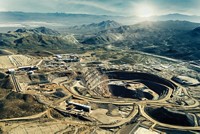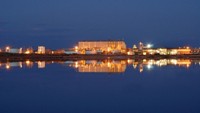Advertisement
Grab your lab coat. Let's get started
Welcome!
Welcome!
Create an account below to get 6 C&EN articles per month, receive newsletters and more - all free.
It seems this is your first time logging in online. Please enter the following information to continue.
As an ACS member you automatically get access to this site. All we need is few more details to create your reading experience.
Not you? Sign in with a different account.
Not you? Sign in with a different account.
ERROR 1
ERROR 1
ERROR 2
ERROR 2
ERROR 2
ERROR 2
ERROR 2
Password and Confirm password must match.
If you have an ACS member number, please enter it here so we can link this account to your membership. (optional)
ERROR 2
ACS values your privacy. By submitting your information, you are gaining access to C&EN and subscribing to our weekly newsletter. We use the information you provide to make your reading experience better, and we will never sell your data to third party members.
Environment
Concern Grows Over Rare-Earths Supply
Government tries to respond to U.S. vulnerability in these critical materials
by David J. Hanson
May 16, 2011
| A version of this story appeared in
Volume 89, Issue 20

The increasing awareness of potential shortages of critical rare-earth materials in the U.S. is getting a government response this year. Despite the challenges of mining these materials, their importance to the manufacture of a wide array of products, from gasoline to electronics and hybrid cars, is prompting Congress to take action to ensure an adequate supply in the U.S.
Since the 1990s, the low cost of mining operations in China, combined with costly environmental and permit regulations in the U.S. and other nations, has driven almost all non-Chinese rare-earths operations out of business (C&EN, Aug. 30, 2010, page 9). Most observers estimate that China presently mines and produces about 97% of the world’s supply of rare-earth metals and oxides. While that supply may be adequate for most world uses, in recent months China has announced it is severely cutting its exports of these materials because of its own rising demand and new environmental restrictions. As a result, prices for rare earths have skyrocketed and concerns about supply interruptions in the U.S. have grown.
The rare-earth metals are typically defined as the 15 lanthanides plus scandium and yttrium. The elements are used in various industries. In the petroleum industry, lanthanum and cerium are critical materials in catalysts used to produce gasoline, according to the Department of Energy. Neodymium and samarium are needed to make powerful magnets, and indium is used to make photovoltaic films.
DOE issued its assessment on the use of these critical materials last December, and the Department of Defense is slated to publish its own analysis of rare earths’ importance to national security in July. Many of the national security concerns tied to rare-earths supply were set forth in a study by the Congressional Research Service (CRS) released at the end of March.
These studies and others point out that there is no actual global shortage of rare-earth minerals, but that the lack of any domestic production makes the U.S. vulnerable to supply interruptions. Some of the recommendations in the CRS study call for the U.S. to create a stockpile of the most critical compounds, invest more in U.S. rare-earths production, and increase international collaboration to improve rare-earths availability.
In response to the vulnerability, bills have been introduced in the Senate and the House of Representatives that “run the gamut from resources assessments, to pure research and development bills, to comprehensive bills focused on energy,” says Jeffery A. Green, of J. A. Green & Co., a Washington, D.C., consulting company specializing in the rare-earths problem. “The spectrum runs from just studying the issues to actually getting out there to rev up production.”
Congress is most concerned about the use of rare earths in national security and energy-efficiency technologies. According to the CRS report, DOD estimates the U.S. uses about 5% of the world’s production of rare earths for defense purposes. For instance, the agency uses samarium cobalt magnets for disk drive motors on aircraft, tanks, and missile systems; in lasers for mine detection and various countermeasures; and in satellite communications and radar aboard ships and submarines. SmCo magnets are seen as ideal for such defense purposes because they retain their magnetic strength at elevated temperatures.
Gareth P. Hatch, founding principal of Technology Metals Research and a longtime expert in the rare-earths field, sees the supply of rare earths as a legitimate national security concern, but notes that national defense use is not the biggest player in the game. “From a volume and impact point of view, it is the role of clean energy that is going to be the driver in terms of innovation and activity around rare-earth materials,” Hatch claims. He says the DOE report focused on critical materials used for clean energy technologies because that is where the market is in terms of growth, especially for items like lightweight magnets and energy-efficient phosphors.

Hatch also stresses the importance of rare earths to petroleum refining. About a fifth of the demand for rare earths goes into catalysts that help generate gasoline. “There is a real issue concerning lanthanum,” which boosts the efficiency of gasoline manufacture by 10 to 12%, he says. “If we don’t have lanthanum, our oil refineries might shut down.”
Rep. Mike Coffman (R-Colo.) introduced the most comprehensive legislation the House is considering. The Rare Earths Supply-Chain Technology & Resources Transformation Act of 2011 (H.R. 1388) sets up several programs, including a rare-earths program operated by the U.S. Geological Survey (USGS) to ensure a sustainable supply of these materials, a loan guarantee program for rare-earth development, and enhancements to R&D programs on rare earths.
“The Coffman bill is very prescriptive,” Green notes. “It talks about setting up a limited defense inventory and getting more production going for alloys and magnets in the U.S.” Green sees it as the strongest contender in the House for dealing with these critical materials.
In the Senate, the main bill is expected to come from Sen. Lisa Murkowski (R-Alaska), who floated a draft rare-earths bill last month. Murkowski’s bill also sets up a supply-monitoring program within USGS. The bill is expected to require the federal government to develop a strategy to ensure that the U.S. has an adequate supply of these materials. “With so much attention paid to our reliance on foreign oil, it is easy to lose sight of the fact that other minerals are as critical to our economy,” Murkowski said when announcing her bill.
As the senior Republican member of the Senate Energy & Natural Resources Committee, Murkowski has the clout to get her bill on the Senate floor. “If she can get the endorsement and cooperation of the committee chairman, Jeff Bingaman Jr. (D-N.M.), I think it has a good chance,” Green tells C&EN. “The bill does some good things. It comes up with some actionable solutions, it focuses on R&D, and it talks about the needs of manufacturing.”
The bills in Congress must deal with the impact of U.S. environmental regulations on mining. For example, complying with water supply regulations—by containing acid waste generated during the mining—can be prohibitively expensive. Many observers point to these regulations as a prime reason that mining and processing of rare earths closed down in the U.S. and moved to China.
“We have an extremely complex web of environmental laws that requires multiple federal agencies to sign off on any proposal,” says Luke Popovich, vice president for external communications of the National Mining Association. “And that is not even including the state laws and regulators who have interest in the process.” Popovich believes the current concerns over rare-earths supplies may improve the permitting process for mining.
“We’d like to see the federal agencies look at how they manage permit approvals,” Popovich says, “and for them to decide how impediments to permitting can be removed or reduced.” The mining association points out that the U.S. has one of the longest permitting processes for mining in the world. “It’s not uncommon to wait six to 10 years for a permit,” Popovich says.
Fighting through the permit process is Molycorp, which is working to start production at its rare-earths mine in Mountain Pass, Calif. The mine, which was closed in 2002 because of environmental problems, is the largest rare-earths mine in the U.S. and set to begin ore production again under new management in 2012. Other U.S. projects under way include the Bear Lodge, Wyo., site operated by Rare Element Resources and a project in Alaska called Bokan Mountain, which is under development by Ucore Rare Metals.
U.S. companies hope to beat China by mining smarter. “Molycorp is looking to get twice as much material from its ore as do the Chinese,” Hatch says. “They are looking to reprocess and recycle. So it appears that they can compete through the judicious use of technology.”
Another avenue the Obama Administration is exploring to ensure the U.S.’s rare-earths supply is the World Trade Organization (WTO). China’s export restrictions on its rare-earths production have led the Office of the U.S. Trade Representative to denounce the actions and threaten to file a WTO complaint. “The trade representative is very active in this,” Green says, “because there have been a lot of very questionable trading practices out of China.”
Although the U.S. did file a formal WTO complaint over a number of Chinese trade policies in 2009 that should be resolved soon, action specific to rare earths is still being considered. “We remain very concerned by China’s systemic use of these export restraints,” a trade representative spokesman tells C&EN. “We continue to examine China’s polices and practice with respect to rare earths and are in the process of closely investigating those matters.”
The political partisanship in this Congress makes passing any legislation difficult, even relatively noncontroversial bills like the rare-earths legislation. It is expected that they will have to be attached to other, more essential bills in order to become law. “I think you are likely to see these big pieces of legislation broken up and included in other bills,” Green predicts. “It’s much easier to put a piece of legislation on a defense bill that is going to pass than to do it as a stand-alone bill.”




Join the conversation
Contact the reporter
Submit a Letter to the Editor for publication
Engage with us on Twitter